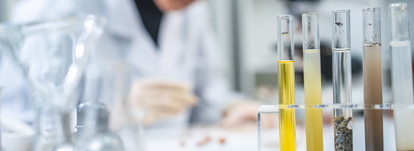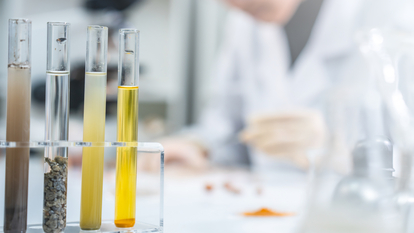Our analyses in figures
46%
Analysis of solid waste, soil, and land
23%
atmospheric emissions analysis
19%
analysis of wastewater, groundwater, and water intended for human consumption
12%
Liquid waste and process effluents

Our internal laboratory provides analysis, consultancy, studies, and applied research especially for environmental issues in solid, aqueous, and gaseous matrices.
Having real and concrete data on the substances that a company uses, produces, or emits is fundamental to monitor the impact on the surrounding environment and the safety of the people working there.
The chemical and physical analyses we carry out concern atmospheric emissions, wastewater, the waste produced, and the soil.
Thanks to the use of cutting-edge laboratory equipment, Gesteco Laboratories are able to meet the analytical methodologies required or recommended by national, regional laws or by national and/or international entities such as APAT, UNI, NIOSH, ASTM, ISO, EPA, and APHA.
The laboratory of Gesteco is able to perform analytical determinations for various compounds. The analyses are conducted by specialized personnel and must comply with environmental regulations and local regulations.
The analysis of waters intended for human consumption, including groundwater and aqueducts, is a fundamental element to ensure that the water we drink is safe and potable. These analyses are aimed at evaluating the water quality, identifying any contaminants, and verifying compliance with drinking water regulations and standards.
Water analysis includes a series of parameters that are measured and evaluated according to what is provided for by Legislative Decree 18/2023 for waters intended for human consumption, and by Legislative Decree 152/2006 for groundwater. These parameters may include the presence of chemical substances such as heavy metals, pesticides, volatile organic compounds, nitrates, and other contaminants. Microbiological parameters are also evaluated, such as the presence of bacteria, viruses, and other pathogenic organisms, which may pose a risk to human health.
The wastewater analysis concerns specific molecules, in line with the production process, which include:
In addition to the chemical profile, acute toxicity tests on microorganisms are also of interest.
The checks are carried out in accordance with the authorization as provided for by Legislative Decree 152/2006, depending on whether the discharge is made into the sewerage system, into surface water, or directly into the soil.
The analysis of air and emissions into the atmosphere is a fundamental field of study for evaluating the effect of human activities on the environment and on the air quality we breathe.
These analyses provide valuable information about the presence and concentration of atmospheric pollutants, as well as the impact of industrial, vehicular, and other anthropogenic emissions. These atmospheric pollutants include, for example, nitrogen oxides, sulfur dioxide, carbon monoxide, fine particulate matter, volatile organic compounds, and many others.
Usually, the analyses are conducted using tools such as air samplers, gas analyzers, mass spectrometers, and advanced sensors. The collected data is then processed and analyzed in accordance with D.Lgs. 152/2006.
The analysis of industrial solid waste is a fundamental activity for understanding the nature and characteristics of waste generated by industrial processes. This analysis can be useful for evaluating the recovery potential of the waste itself and for developing more sustainable management and disposal strategies.
When analyzing industrial solid waste, it is important to take into consideration the process by which they originate: waste can derive from a wide range of industrial sectors, such as the chemical, food, pharmaceutical, manufacturing, and energy industries.
Each sector can generate waste with different chemical, physical, and biological compositions, based on the raw materials used, production processes, and technologies employed.
The analysis of industrial solid waste usually involves several phases:
Characterization of waste and assessment of hazardousness
This phase involves the identification and quantification of different types of generated waste. The physical properties (such as density, shape, and consistency), chemical properties (such as chemical composition, pH, presence of toxic substances), and biological properties (such as the presence of microorganisms) of the waste are analyzed.
Once the characteristics of the waste have been analyzed, it is possible to evaluate the possibilities of recovery. Waste recovery can occur through various techniques, such as recycling, regeneration, energy valorization, or use as raw material in other production processes. The analysis takes into account the technical and economic requirements to determine the feasibility of recovery.
The analysis of soils and rocks for reuse is an important activity to assess their suitability and compatibility with specific reutilization purposes.
This analysis can be valuable in a variety of contexts, such as the remediation of contaminated sites, the construction of infrastructure, the filling of degraded areas, or the recovery of excavation materials. During the analysis, various key factors are considered and the laboratory is responsible for determining the concentrations of heavy metals, hydrocarbons, organic contaminants, or other toxic compounds.
This analysis is fundamental to ensure environmental safety and compliance with current regulations (Legislative Decree 152/2006 and DPR 120/2017) and contributes to responsible management of natural resources, waste reduction, and improvement of environmental sustainability.

Ecotoxicity tests are biological assays that, using model organisms, provide a comprehensive overview of the toxic effects of individual pollutants or mixtures of substances. This ability to integrate diverse data makes toxicity tests an essential tool for an enhanced environmental risk assessment.
Our tests adhere to both national and international protocols and guidelines, delivering reliable results.
Recent environmental legislation, such as Legislative Decree No. 152/2006, explicitly requires ecotoxicity assays for municipal and industrial discharges, aiming to safeguard aquatic ecosystems.
The laboratory also conducts additional biological assays on various types of matrices.
Through the analysis of ecotoxicity test results, it is possible to identify and quantify the risks associated with exposure to specific substances.
We also provide consultancy services for interpreting results and managing data, supporting you in communications with regulatory authorities.
Gesteco’s Ecotoxicity Laboratory performs the following analyses:
The ecotoxicology laboratory of Gesteco performs the following analyses.
The Gesteco laboratory has the ACCREDIA accreditation n. 00508 Testing REV. 05. Here you can view the list of our accredited tests and the related analytical methods used.
Our analytical laboratory can rely on highly qualified professionals holding scientific degrees and specific technical expertise, including:
PhD holders with a Master's degree;
Graduates in Chemistry;
Graduates in Ecology;
Graduates in scientific disciplines, with specialisations in biotechnology, environmental sciences, health sciences, natural sciences eand animal sciences;
Graduates from scientific secondary schools;
Chemical industrial technicians.

Analysis of solid waste, soil, and land
atmospheric emissions analysis
analysis of wastewater, groundwater, and water intended for human consumption
Liquid waste and process effluents